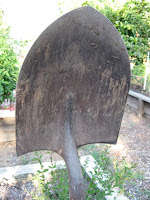On a recent Saturday afternoon I was involved in a typical weekend routine: roaming the corridors of a local home supply store, ogling the array of utility trailers, garden tillers, backpack leaf blowers, log splitters and power augers (a definite sign of aging).
Another male shopper broke into my garden tool reverie and asked if I knew anything about a nearby display of shovels. Just because I wear overalls while shopping, people sometimes mistake me for a "Norm" clone from "This Old House", moonlighting in a retail establishment.
Or, maybe it's the bright orange jacket, which is perfect for attending SF Giants games, but not so perfect for maintaining civilian anonymity at a Home Depot.
The truth be told, I can’t hammer a nail straight into wood or saw a piece of plywood without drifting off the line. But shovels? Hey, now you’re in my aisle.
"What are you going to use the shovel for?", I asked.
"To dig a hole", came the polite but perplexed reply.
"Ah, now we’re getting somewhere. What sort of hole?", I asked.
"One in the ground," he answered, rolling his eyes. "For a bare root fruit tree."
Bingo.
"Then what you want is a digging tool," I said.
"Thanks, Einstein," came his retort as he left in a hurry, probably in search of the store manager.
That’s the price I pay for knowing too much about the right shovel for the right job. If he had stuck around, I would’ve gone into my fifteen minute monologue about shovels:
Use a round-nose shovel for digging. The tip is pointed to cut through roots or heavy soil. Its sharp edge also helps you get a little deeper, a little quicker.
A flat nose shovel with rolled shoulders is ideal for moving, loading or unloading lightweight materials, such as mulch or compost.
Use a garden spade with a flat, sharp edge for cutting out sod, breaking apart crowded rootstocks such as agapanthus or canna lilies, or smoothing off the sides of a trench.
A trenching or transplanting spade for digging a horizontal trench for irrigation or drainage; the ones with a slightly wider blade are for moving shrubs.
 Although not technically a shovel, a spading fork
Although not technically a shovel, a spading forkAnd a snow shovel, for something I hope I never have to do here in Sacramento.
He also missed my speech about shovel quality and maintenance:
Handles are usually made of fiberglass or wood. Choose wood if you tend to keep your tools indoors. A fiberglass handle can take the weather a bit better, especially if you tend to rediscover your shovels when you mow for the first time in spring.
A long handled shovel offers more leverage when digging big holes.
Short handled shovels are great when working in tight quarters.
Keep the shovel sharp. A dull shovel tip is as effective as a dull knife (useless). It won’t penetrate soil, especially compacted or heavy clay soil.
Be willing to pay more for reinforced handles; that helps insure a longer shovel life.
Apply linseed oil with a rag twice a year on the wood handles.
Clean the metal surfaces after every use with a wire brush, coarse steel wool or an oily rag.
Store shovels in a dry location.
But considering the scowls I see from store personnel who witness these encounters, the next time someone mistakes me for an employee in the shovel aisle, I think I'll say, "Sorry, I work in the plant department."








Thank you! Appreciate all the info. :-)
ReplyDeleteSara